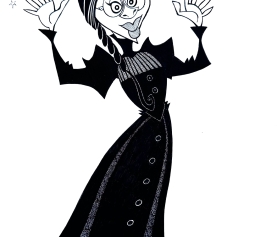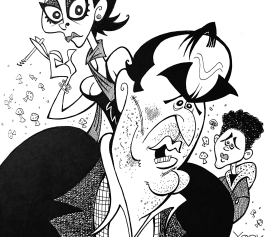
Original caricature by Jeff York of Cynthia Erivo in THE OUTSIDER (copyright 2020)
The HBO miniseries THE OUTSIDER was a big success for the premium cable network, building steadily in the ratings over its 10-week run. Because of that prowess, it’s likely to get an order for a second season. The latest Stephen King adaptation had many attributes, but part of its appeal may very well have been the topicality of the material. In the show that just wrapped up with this past Sunday, the drama centered around an otherworldly virus traveling from one human being to the next through bodily contact, leaving death and havoc in its wake. Sound familiar? It’s quite possible that, unintentionally, THE OUTSIDER became the first show in the Coronavirus age.
Granted, it wasn’t a literal pandemic story like the movie CONTAGION was back in 2011, showcasing how a virus similar to COVID-19 could spread throughout the world. (Incidentally, that Steven Soderbergh film has become a top VOD rental again.) Instead, the “virus” in THE OUTSIDER came from some sort of demon or alien, never wholly explained, and a better show for it. The infection was transmitted through one human with the virus scratching another and thus, the parasite would gain access through the bloodstream. It would eventually crystallize into pronounced blisters on the back of the victim’s neck until the alien lifeform could take over the victim, turn him or her into its virtual slave, and slowly replicate the form into a perfect doppelganger to walk about the earth and feast on humans. (The virus was especially vicious, preferring to eat children because they tasted all the sweeter.)
As gross as the transformation was, the crux of the 10 hours here wasn’t to be grotesque. Rather, it was to build dread exponentially. The frightener didn’t traffic in jump scares or instant gratification. Instead, it took its painstaking tie, sometimes taking too long. (Arguably, the show couldn’t have been done in 7-8 hours.) Still, for television, it was a significant achievement, taking its time in an era when everyone wants everything bingey and immediate.
The story started with the murder of a pre-teen boy and the investigation into matters by the local authorities. The tight-knit community was shocked when popular teacher Terry Maitland (Jason Bateman) was arrested, but that’s whom numerous eyewitnesses fingered. Detective Ralph Anderson (Ben Mendelsohn, almost doing a droll riff on Humphrey Bogart-esque masculinity) had the unenviable task of arresting Maitland as he protested his innocence.
Things got complicated when Maitland’s lawyer (Bill Camp) produced video from another city that showed Maitland had business there during the same date that the murder took place. How was that possible? Was there a parallel universe, one that allowed Maitland to be in two places at once? How could there possibly be two Terry’s?
Before the authorities could broaden the investigation, Maitland ends up getting shot dead by a family member of the pre-teen victim. As Anderson, et al. looked into matters more, they discovered a pattern where two of the same person seem to be living separate lives, with one of the ‘twins’ committing horrible acts of violence against children.
To help understand the otherworldliness of it all, Anderson brings in Holly Gibney (Cynthia Erivo), an eccentric, even borderline, private investigator with an almost supernatural sense of things herself. Ultimately, with her willingness to believe that a legendary demon named El Coco could be responsible, Anderson and his fellow detectives discover the parasite and go a-hunting for it.
It was a crackling mystery, weird science fiction, a bloody procedural, and shrewd social commentary all rolled into one. The miniseries conjured up a similar weirdness evident in the works of David Lynch and Stanley Kubrick: lots of deliberate pacing, bizarre characters, and wholly immersive worlds. It riffed on THE SHINING, THE STAND, IT, and a host of other King bestsellers. The Gibney character is featured across a number of the author’s books.
In addition to being so “of-the-moment” with its parallels to COVID-19, there were two other factors that likely contributed greatly to its appeal as well. From the opening moments of the show, THE OUTSIDER laid itself out as much of a mood piece as a procedural. It was dank and dour, gray and dreary, albeit done with a self-conscious artsiness. Every single shot was framed for maximum weirdness and tension. Camera angles were cocked, POV shots were either too far away or too close to the actors…perhaps it was over-directed, but every single second was designed to be unsettling, and indeed, it certainly was.
The sound design created a tense underscore throughout with its ominous humming. The performances felt tense too and wholly gloomy as if everyone were talking in hushed tones at a funeral. In a way, they were attending the death of norms in their world, so they all fit.
The one performance that brought some levity to the affair was Erivo. Her Gibney was always bluntly honest, calmly interrupting others to spit out truths that others were avoiding. The character even lacked propriety at times, but Gibney’s candor was almost an elixir amongst all the constipated characters around her. Erivo turned Gibney, quirks and all, overly coiffed hair and boyish Gap clothing, into one of the more interesting sleuths ever to grace the small screen. Gibney easily joins the ranks of intrepid oddballs who somehow are ingratiating to the audience like Columbo, Sherlock, and Monk.
If the show gets a second season, they should put Erivo’s Gibney front and center. After all, they have those other King stories that she’s featured in, and Erivo is a gift to any production, be it a musical or a procedural. Hopefully, the COVID-19 virus will be gone by the time the second series rolls around in a year or so. If not, there may not be much of an audience left to even watch it.







